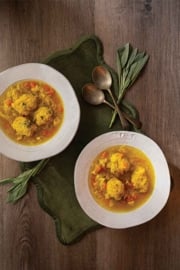Papaya Salad (Som Tam)

The explosion of flavours and unforgettable textural contrasts makes this refreshing Thai salad one of the great gastronomic pleasures when visiting the Asian nation. Make it for a light lunch or dinner side dish. Often, the heat-loving Thai will add a handful of chili peppers. But if you’re not after revenge, it’s best to only use one or two for more sensitive palates.
Green papaya is just the unripe fruit, so its flesh has a cabbagelike texture when grated. Most Asian markets stock it, but if unavailable, green mango is a good substitute. An authentic recipe calls for a large mortar and pestle to mash everything, but it’s very much possible to make a great tasting dish without one.
The salad stays crisp in the fridge for a couple of days, but add the peanuts only when serving so they stay crunchy.
2 garlic cloves, peeled
1 to 2 chopped Thai or serrano chili peppers, depending on heat tolerance
Juice of 1/2 lime
2 Tbsp (30 mL) fish sauce
1 Tbsp (15 mL) coconut palm sugar or honey
8 to 10 snake (long) beans, cut into 2 in (5 cm) lengths (or substitute green beans)
1 green papaya, peeled and shredded with serrated vegetable peeler, mandoline, box grater, or food processor with grating attachment
2 cups (500 mL) cherry tomatoes, halved
2 Tbsp (30 mL) dried shrimp (optional)
1/4 cup (60 mL) unsalted roasted peanuts, roughly chopped
6 Napa cabbage leaves, torn
Pound garlic and chili pepper in large mortar and pestle until crushed. Add lime juice, fish sauce, and sugar or honey; stir until all the sugar is dissolved. If not using a mortar, process the ingredients together in food processor or spice grinder. You can also use the flat side of chef’s knife to make garlic-chili paste and then mix with the other ingredients in small bowl.
Add beans, green papaya, tomatoes, and shrimp to mortar, and pound gently just to bruise and soften the contents. Make sure to flip the contents as you pound. If not using a mortar, lightly crush the beans with the flat end of a chef’s knife or rolling pin, and add to large bowl with papaya and dried shrimp. Using your hands, massage ingredients to soften and then stir in fish sauce mixture.
Add peanuts and mix well. Serve with cabbage leaves.
Serves 5.
Each serving contains: 165 calories; 7 g protein; 4 g total fat (1 g sat. fat, 0 g trans fat); 30 g total carbohydrates (12 g sugars, 10 g fibre); 583 mg sodium
source: "Stir-Up Delicious Thai Food", alive #364, February 2013





